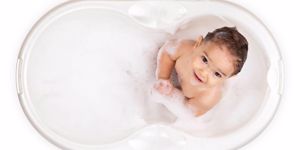Bathing a slippery squirming, and sometimes crying baby takes practice. The good news is that it will get easier! Don't be surprised if your baby cries during their first few baths. It’s just a reaction to an unfamiliar sensation. Keep the room temperature warm, the bathwater comfortable and soothe your baby by caressing and singing to her.
How often do I need to bathe my baby?
A newborn only needs bathing two or three times a week, as long as you keep their nappy area well-cleaned and wash their hands and face regularly (top and tail).
For older babies, it could be as much as every day, as a bath often becomes part of the bedtime routine and can be a lovely way for your baby to relax.
Baby Bath Water Temperature
Your baby's skin is more sensitive than yours. Before you put your baby anywhere near the water, test it with the back of your wrist or your elbow: These areas are more sensitive to heat than your hand. The water should feel warm – but not hot!
Sponge Bathing
Before your little one’s umbilical cord stump falls off (between 10 days and three weeks after birth) it’s best to sponge-bathe them to avoid getting the cord stump wet.
- Lay your baby on a soft, flat surface (on top of a clean towel works well). Have a basin of warm water and a sponge or flannel handy.
- Keeping your baby warmly wrapped, expose one limb at a time and gently wash it.
- Pat the area dry and start on the next limb.
- If you accidentally get the cord stump wet, simply use the towel to gently pat it dry.
Once the cord stump has fallen off, your baby is ready for a real bath in a baby bathtub. Make sure you have everything to hand before so you won’t be scrabbling about.
Here's a sample list:
- A large, hooded towel
- A soft flannel or sponge
- Cotton balls
- Baby soap or bath wash
- A baby brush or comb
Hold your baby firmly and gently wash away any debris or loose skin that's accumulated. You'll have to cradle their head and back as you wash them. Wash your baby's hair last so she doesn't have to sit in soapy water. Pay particular attention to:
- The genital and nappy areas.
- The hands and feet. Check between the fingers and toes as well.
- The folds at the backs of the knees, the neck and the thighs.
- The face. If debris has accumulated around her eyes, use a cotton ball to swab it away.
- Armpits – fuzz from sleep-suits can accumulate here.
- Behind the ears.





